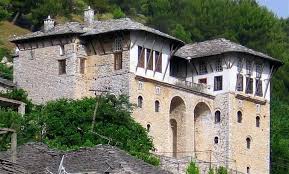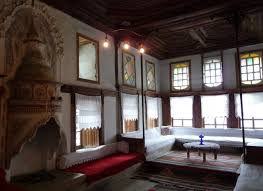
Cascading downhill from the castle to the valley floor, the stone houses of Gjirokastra are unique. The tall buildings range from a simple tower structure, three or four stories high, to houses with one or two wings, as in the beautiful Zekate House near the top of the hill.
The finest example of an Albanian Ottoman house, built in 1813
The ground floor was for storage and defence. Living quarters were on the higher floors, with one room having a large chimney hood over a fireplace. this was the winter room. In the larger rooms there were balconies for life during the heat of summer.
View across the town and the Drinos Valley from the summer balcony.
The ‘guest room’, where visitors were received, was always the most ornate room, with carved and sculpted ceilings and fine rugs and cushions. All around the walls are divans, covered with kilims or rough linen sheets. These served as seating during the day and as beds at night.

Across the whole town the roofs of the old houses are made of thick, stone tiles. This gives the city a uniform appearance when viewed from above.
From below, there is a mix of white, Ottoman style walls, with the local grey stone. It is an attractive city. However, while the Museum zone of the town is protected, illegal building work goes on. In addition, every year some houses collapse beyond repair.
The house of the writer Ismail Kadare is under restoration after being destroyed by fire in 1999.
The house of the writer Ismail Kadare is under restoration after being destroyed by fire in 1999.


A fabulous post, Beth, and great photos!
ReplyDeleteGlad you enjoyed it, Kristine. I wholeheartedly recommend Albania for a touring holiday. Breathtaking scenery and welcoming people.
ReplyDelete